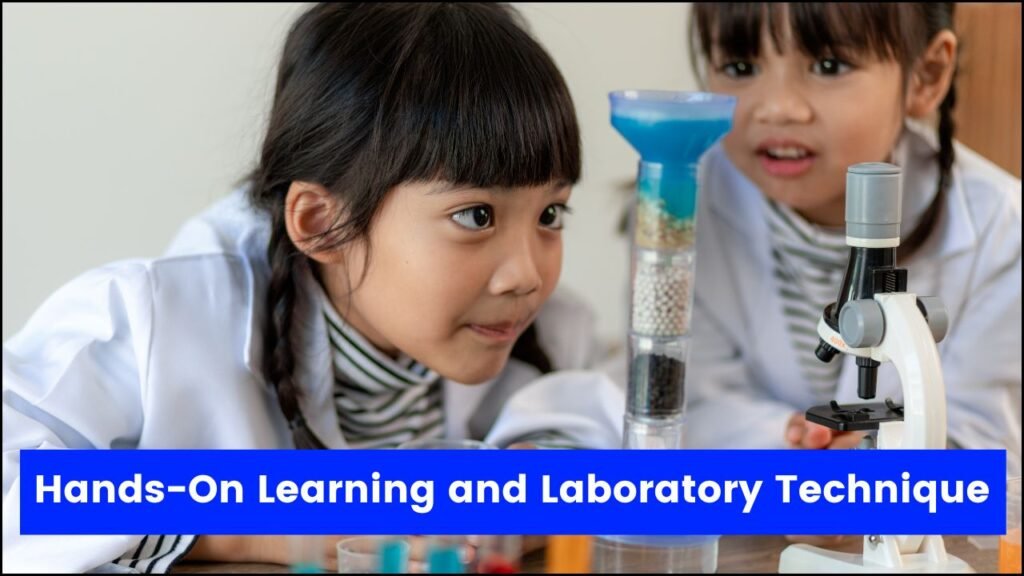
Science education plays a key role in helping students understand the world around them. Classroom theories alone cannot give the full picture. Real learning happens when students touch, observe, and experiment. Hands-on laboratory learning is not just a tradition in science—it is a powerful tool that helps students gain real skills. In modern classrooms, labs are becoming more interactive, technology-based, and student-centered. This article explains how hands-on learning and lab techniques are shaping the future of science education.
Table of Contents
Trends in Modern Science Labs
Shift Toward Inquiry-Based Learning
- Learning Method: Students now explore questions rather than memorize answers.
- Student Role: Students design experiments, gather data, and draw conclusions.
- Example: Dissection activities let students explore real animal anatomy.
- Benefits:
- Encourages curiosity.
- Builds problem-solving skills.
- Improves critical thinking.
Integration of Technology
- Tools Used: Virtual Reality (VR), Augmented Reality (AR), and stylus pens.
- Learning Style: Students interact with 3D models and digital simulations.
- Example: A virtual frog dissection or exploring a cell’s parts in VR.
- Benefits:
- Makes hard topics easier to understand.
- Helps visual learners grasp complex concepts.
- Connects theory with real-world visuals.
Ethical Considerations and Alternatives
- Problem: Many students feel uncomfortable with real animal dissections.
- Solutions:
- Digital dissection software.
- 3D-printed models.
- Benefits:
- Supports student comfort and values.
- Still teaches anatomy and lab skills.
- Promotes kindness and ethical awareness.
The Importance of Hands-On Experiences
Active Engagement
- Activity Style: Students participate directly in the learning process.
- Examples:
- Mixing chemicals to see reactions.
- Observing plant growth in different soils.
- Benefits:
- Improves memory of lessons.
- Increases interest in science.
- Makes learning fun and meaningful.
Real-World Relevance
- Purpose: Students learn how science affects daily life.
- Examples:
- Measuring pH in drinking water.
- Testing materials for strength in physics.
- Benefits:
- Links school lessons to everyday life.
- Shows why science matters.
- Builds practical understanding.
Skill Development
- Skills Gained:
- Observation and accurate note-taking.
- Use of lab tools and safety measures.
- Teamwork and communication.
- Career Use: Useful in all STEM (Science, Technology, Engineering, Math) jobs.
- Benefits:
- Prepares students for science fields.
- Builds confidence in lab work.
- Teaches collaboration and responsibility.
Comparison: Traditional vs. Modern Science Labs
| Feature | Traditional Labs | Modern Labs |
|---|---|---|
| Learning Style | Teacher-led, theory-focused | Student-driven, inquiry-based |
| Technology Use | Minimal or none | VR, AR, simulations, digital tools |
| Dissection Method | Real animal dissection | Digital tools, 3D models |
| Student Involvement | Passive listeners | Active explorers |
| Skill Focus | Memorization | Critical thinking, problem-solving, hands-on skills |
| Ethical Sensitivity | Often overlooked | High priority, with flexible learning options |
Examples of Hands-On Lab Activities
| Lab Type | Activity Description | Skills Taught |
|---|---|---|
| Biology | Dissecting a virtual frog or plant parts | Anatomy, observation |
| Chemistry | Mixing acids and bases to test pH levels | Safety, measurement, chemical reactions |
| Physics | Building simple machines or testing motion with toy cars | Mechanics, prediction, and data recording |
| Environmental Science | Measuring air quality or water contamination | Data analysis, environmental awareness |
| Earth Science | Simulating volcanic eruptions with baking soda and vinegar | Cause-effect understanding, creativity |
Benefits of Hands-On Science Labs
| Area | Benefits |
|---|---|
| Academic Performance | Higher test scores and deeper understanding |
| Motivation | Increased interest and participation in science |
| Collaboration | Better teamwork and communication skills |
| Career Readiness | Prepares students for jobs in science and research |
| Problem Solving | Builds logical thinking and solution-seeking behaviors |
Lab Safety and Responsibility
| Safety Measure | Why It Matters |
|---|---|
| Wearing goggles and gloves | Protects eyes and skin from harm |
| Reading instructions | Ensures correct use of materials |
| Labeling chemicals | Prevents accidents and mix-ups |
| Cleaning workspace | Keeps the lab organized and prevents contamination |
| Reporting accidents | Ensures quick help and safety for all |
Future Directions in Science Labs
- Virtual Labs: Students access labs online from any location.
- Cross-Disciplinary Projects: Combining biology, chemistry, and tech in one experiment.
- Student-Led Research: Schools are encouraging original investigations and science fairs.
- Community Science: Working with local groups on real-world problems (like pollution).
Teacher’s Role in Hands-On Science
| Responsibility | Impact on Students |
|---|---|
| Designing meaningful labs | Ensures students gain useful knowledge |
| Encouraging curiosity | Helps students think beyond textbooks |
| Ensuring safety | Protects everyone during experiments |
| Providing feedback | Improves student performance and confidence |
| Using technology wisely | Keeps students engaged and up-to-date with modern tools |
Closing Reflections
Hands-on learning and lab experiences are essential in making science real for students. Lab activities, whether traditional or high-tech, give students the chance to discover, question, and explore. With a careful mix of technology, ethical options, and guided inquiry, science education becomes more exciting and effective. Equipping students with hands-on skills today ensures that tomorrow’s researchers, doctors, and engineers are ready to lead the world forward.





